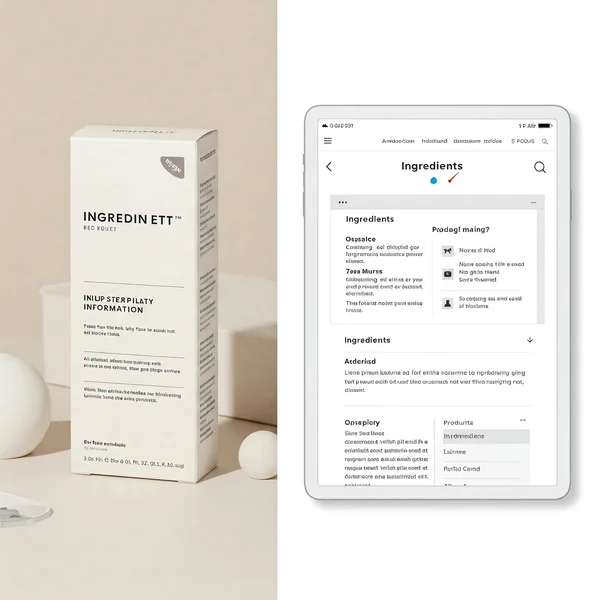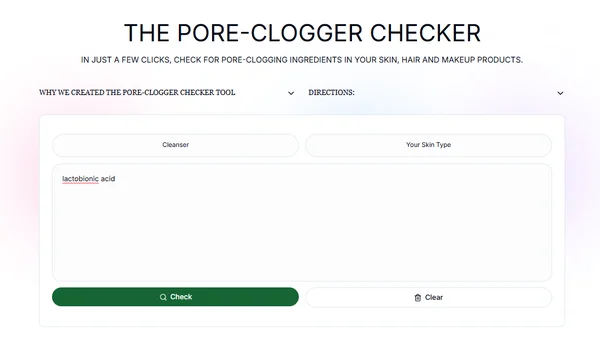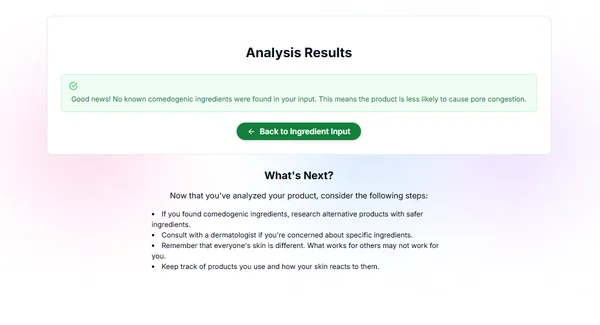How to Use Our Pore Clogging Checker Tool Like a Pro
So, you've heard about the importance of avoiding pore-clogging ingredients, but deciphering those lengthy product labels feels like a chemistry exam? Manually cross-referencing every single item against lists of comedogenic ingredients is time-consuming and honestly, quite frustrating. How to use a pore clogging checker effectively? Thankfully, technology offers a simpler way. This guide will walk you through exactly how to use our specialized ingredient checker skincare tool to analyze product formulations quickly and confidently, like a pro.
Getting Started: Finding & Copying Ingredient Lists
Before you can use any checker, you need the raw data: the product's full ingredient list. Where can you typically find this crucial information?
Where to Find Product Ingredient Lists
Look for the ingredient list (often labeled "Ingredients" or "INCI") in these places:
-
Product Packaging: Usually on the back or bottom of the box or container.
-
Brand's Official Website: Most reputable brands list full ingredients on their product pages.
-
Retailer Websites: Major online beauty retailers (like Sephora, Ulta, etc.) often include ingredient lists on product pages.
-
Specialized Databases: Websites dedicated to cosmetic ingredients sometimes list full formulations (though double-check accuracy).

Tips for Accurate Copying
Accuracy is key for the checker to work correctly:
- Copy Everything: Ensure you capture the entire list, exactly as it appears.
- Check Formatting: Make sure ingredients are separated correctly (usually by commas). Avoid copying extra text like "Key Ingredients" headers or marketing descriptions.
- Use Plain Text: If possible, paste the list into a plain text editor first to remove any weird formatting before putting it into the checker.
Once you have the clean ingredient list ready, you're set for the next step.
Guide to Using the Pore-Clogging Detection Tool
Ready to check ingredients? Using our dedicated tool is designed to be straightforward. Here’s the process:
Accessing the Tool on PoreCloggingChecker.org
First, head over to our website. You can easily find the pore clogging checker interface right on the homepage or via clear navigation links. It's designed for quick access.
Pasting Your Ingredient List into the Checker
You'll see a designated text box, usually labeled "Paste your ingredient list here." Simply paste the ingredient list you copied earlier directly into this box.

Clicking "Check" and What Happens Next
Hit the "Check Ingredients" (or similarly labeled) button. Our pore clogger checker tool will then instantly compare the ingredients you entered against its database of known and potentially comedogenic substances. You should see the results appear quickly below the input box.
Interpreting Your Results: Safe vs. Potential Flags
Now for the crucial part: understanding what the results mean. How do you interpret the checker results?
Understanding "Potential Pore Clogging" Flags
The checker will highlight ingredients that are flagged in its database as potentially pore-clogging or comedogenic. This "flag" serves as a warning – it indicates an ingredient might cause issues for some people, especially those with acne prone skin. It doesn't automatically mean the product will cause breakouts for you, but it's a signal to be cautious or perhaps do further research.

What "Likely Safe" or No Flags Mean
Ingredients that are not flagged are generally considered less likely to be comedogenic based on available data. If your entire list comes back without flags, it suggests the product is potentially a safer choice regarding pore-clogging concerns – a good sign for an acne safe checker result!
Visual Cues or Ratings
(Note: This depends on the tool's specific interface) Our tool might use color-coding (e.g., red for flagged, green for likely safe) or display a numerical comedogenic rating next to flagged ingredients to give you a quick visual assessment of the potential risk level. Familiarize yourself with these visual cues for faster interpretation.
Beyond the Basics: Understanding the Tool's Scope & Limitations
While incredibly useful, it's important to understand what our online tool does and doesn't do.
How Our Database Works
Our pore clogging checker tool works by cross-referencing your pasted list against a curated database. This database is compiled from various sources, including scientific studies and established dermatological lists identifying potentially comedogenic ingredients.
Important Considerations
As covered in our guide to pore clogging ingredients, context matters. An ingredient's concentration in the final product and how it interacts within the overall formulation significantly impact its actual effect. Our tool flags the presence of potentially problematic ingredients; it cannot assess the final formulation's nuances.
Why It's a Guide, Not a Guarantee
Think of the checker as a powerful informational guide, not an absolute guarantee of a product's effect on your unique skin. It empowers you to make more informed decisions about your skincare routine, but individual sensitivities and other factors still play a role. Always patch-test new products if you have sensitive or reactive skin.
Ready to Check? Start Analyzing Ingredients Now!
You're now equipped with the knowledge to use our pore clogging checker like a pro! From finding and copying ingredient lists to understanding the results and their context, you can now efficiently analyze products and make smarter choices for your skin. Stop guessing and start checking!
Don't let hidden culprits sabotage your clear skin goals. Check your product ingredients now using our free, easy-to-use online tool. Take control of your skincare journey today!
What's the first product you're going to analyze using the checker? Let us know in the comments below!
Frequently Asked Questions about Using the Checker
Here are some common questions about our specific tool:
Q1: Is the Pore Clogging Checker 100% accurate?
Is the pore clogging checker accurate? Our tool provides information based on publicly available data and common comedogenicity ratings. However, as mentioned, factors like ingredient concentration, product formulation, and individual skin reactions mean no checker can be 100% predictive for every person. It's a highly valuable guide, but not an absolute guarantee. Use the information provided responsibly.
Q2: What happens if an ingredient from my list isn't found in the database?
What if an ingredient isn't found? If an ingredient isn't flagged, it usually means it's not currently listed in our database as a commonly recognized pore-clogging agent. It could be a newer ingredient, a very rare one, or simply one generally considered safe. We continuously work to update our database.
Q3: Can I use the checker for makeup ingredients as well?
Can I check makeup ingredients? Absolutely! Foundations, concealers, blushes, bronzers – any cosmetic product with an ingredient list can be pasted into the checker. This is particularly helpful for those prone to breakouts caused by makeup.
Q4: How often is the ingredient database updated?
How often is the database updated? We strive to keep the database current by reviewing new research and ingredient information periodically. Our goal is to make the Pore Clogging Checker as up-to-date as reasonably possible.
Q5: Is there a limit to how many ingredients I can check?
Is there a limit? Currently, our tool is free to use without strict limits on the number of ingredients or checks. We want everyone to have access to this helpful skincare ingredient analysis tool.